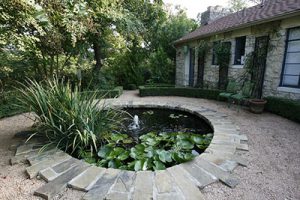Over the last eight weeks we have had lessons on a variety of backyard habitats where wildlife may gather in your yard. Some are natural, like trees, fallen logs, and leaf litter on the ground. Others are more landscaped, like mulch for your bushes or gardens, the gardens themselves, or rock features. And some are provided, such a bird and bat boxes. For those trying to attract wildlife to their yards, these can all be important.

Some are not desired by homeowners, and I get that, but old trees provide habitat for a lot of different creatures. We do not have fallen logs everywhere, but we do have some in one area of our yard. Most folks rake the leaves, I actually enjoy raking, but we have found for parts of our yard the leaf litter is a huge hit with the birds. Every morning we can see the cardinals, thrushes, and wrens picking through it.
We are trying to turn our front yard into a field of flowers. One, we like to look at them – two, the bees and butterflies sure appreciate it. But it has been a tough year this year with no rain. We are getting some and have had a lot of butterflies (monarchs) using them – saw one feeding yesterday. We use rocks to line our side driveway. This is where we have found a lot of cool small creatures. We now have a bluebird box (though I am not sure it is in the best location) and a bat box (which I know is not in the best location) and we will see how it goes.
One thing I have not mentioned that some of you may have – is a water feature. We had one for awhile in our backyard. It was not very big, but it had some plants growing in it, occasionally fish, and frogs… always the frogs. Actually, when my daughters were young and still living here, they would complain about the noise (their bedroom window was near it 😊). Now, they mention how much they miss that sound. We had to move out of our house while it was being repaired one year and we lost the pond during that period. I have thought of doing another but have not. Maybe I will now.

Photo: University of Florida
Some of you may already have water features in your yard and can give others some good advice. I did find a circulating pumping system was needed. Without it the water became stagnant, the frog eggs were gelatinous and made areal mess, and mosquitoes were an issue. The circulating pump helped control this a lot. I heard the mosquito dunks work pretty well. I never used them, reading the safety precautions always spooked me, but I have heard from entomologists (bug scientists) that they are pretty good and do not harm other wildlife.
If you have toddlers, that is always a worry. And I do know homeowners with water features that have attracted snakes – which is probably not desired by most reading this. Those who had that problem usually lived near another source of water (a creek or something). Some may have had problems with birds, we never did. But all in all, the feature was a pleasure to have. Tadpoles are very popular with kids. You could dip water with “weeds” in them and there was a whole world of miniature creatures swimming in there. Speaking of swimming, we did have a dog that would sometimes try this 😊.
Maybe a water feature is something you might consider.
Again, some folks do not want a lot of wildlife in their yards – but for others, particularly the kids, it is great enjoyment. My grandsons spend HOURS searching for rolly-pollies, lizards, skinks, and geckos. They do enjoy the birds, caterpillars, and butterflies. And the occasional glass lizard is always a hit.
With the COVID-19 situation forcing people to stay home more, landscaping your yard to attract wildlife can be enjoyable for adults sitting on the front porch also.
ACTIVITY
– If you have a water feature, explore it today and make a list of all of the creatures you see using it.
– If you are considering putting one in, many of the hardware stores have complete kits for doing it. Check them out.
 0
0
